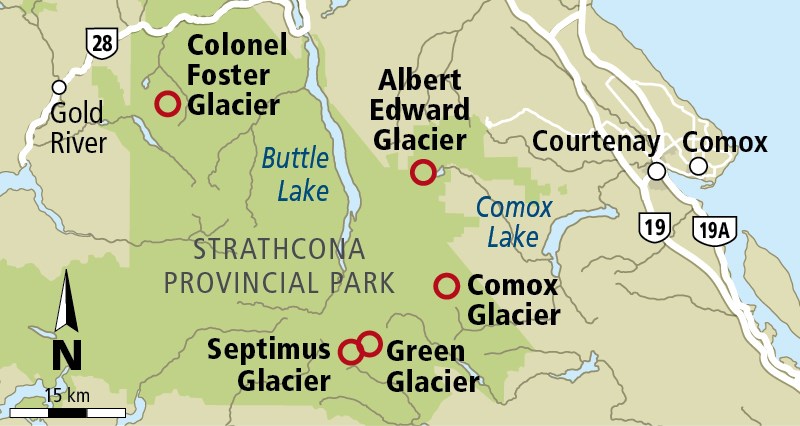All Vancouver Island glaciers, including the iconic Comox glacier, will be gone within 25 years due to climate change, says University of Victoria geography professor Dan Smith.
“There are not many glaciers left,” Smith said Wednesday.
“In the 1970s, they did an inventory on Vancouver Island and they counted about 170 glaciers, and I’d say there are five of what you could call glaciers left.”
Comox glacier at a square kilometre is the largest, but compared with others in the Rockies, “is a tiny little thing,” said Smith.
Glacial melt accelerated on Vancouver Island icefields because they were small to begin with, he said.
The Comox glacier has probably thinned by 60 metres since the earliest air photograph of it was taken in 1931, Smith said.
“It has to retain a certain thickness to retain glacial ice. You look at Google Earth now and there are rocks sticking out all over.”
News that the Comox glacier will soon be gone from the horizon is alarming, said Comox Mayor Paul Ives.
“We look at it every day. Certainly from the town of Comox, it’s the centrepiece of our view.”
Glaciers on the Island aren’t seen as a significant source of water. “They’re really more icons than anything else,” said Smith.
The other four glaciers “have largely disappeared,” he said. “Glaciers are very effective at reflecting temperatures and precipitation changes — they’re very responsive,” said Smith, who is studying other B.C. glaciers that have thinned by 100 metres and retreated five kilometres.
“The significance of what’s going on now is it’s going on on a global scale and seems to be happening more rapidly than in the past,” Smith said.
The loss of Vancouver Island’s glaciers could affect spawning salmon, which need cold water to survive.
Old-timers in the Comox Valley have seen the glacier melt away over the years, Smith said. “They have a pretty good perspective that [the glacier] is changing and it’s changing rapidly, and that pace of change is accelerating as there is less and less ice there.”
Lindsay Elms, author of Beyond Nootka: A Historical Perspective of Vancouver Island Mountains, said he has noticed the Comox glacier thinning in recent years.
A couple of years ago, he tried to hike across the glacier and noticed all the new snow had gone, leaving old snow and ice behind. “There were all these big ponds of water everywhere and, with poor visibility, we ended up deciding we couldn’t go on,” said Elms.
“It’s quite flat up there, easy to get disoriented, so we turned around and came back.”
The conditions pose a hazard for climbers because more crevasses will open up, their locations obscured by snow each winter.
“It increases the potential for falling through into the glacier,” said Elms, an avid hiker.
“A lot of people here in the Comox Valley are wondering, what happens if all the snow goes from the Comox glacier, what happens to our iconic symbol?” Elms said. “I think we are contributing to [climate change],” he said.
A study by the University of Northern B.C. found that between 1985 and 2005, the glacier surface on Vancouver Island dropped from 18.2 square kilometres to 14.5 square kilometres, a loss of 20 per cent.
The average size of Island glaciers is 0.3 square kilometres, much smaller than the provincial average of 2.11 square kilometres.



